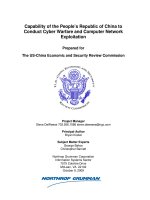Computer Architecture Language of the Computer
Bạn đang xem bản rút gọn của tài liệu. Xem và tải ngay bản đầy đủ của tài liệu tại đây (378.57 KB, 65 trang )
10/11/2011 1
Computer Architecture
Nguyễn Trí Thành
Information Systems Department
Faculty of Technology
College of Technology
10/11/2011 2
Instructions: Language
of the Computer
10/11/2011 3
Instruction Set
The repertoire of instructions of a computer
Early computers had very simple instruction
sets
Simplified implementation
Many modern computers also have simple
instruction sets
Instructions operate using registers
10/11/2011 4
The MIPS Instruction Set
Used as the example throughout the book
Stanford MIPS commercialized by MIPS
Technologies (www.mips.com)
Large share of embedded core market
Applications in consumer electronics, network/storage
equipment, cameras, printers, …
Typical of many modern ISAs
See MIPS Reference Data tear-out card, and Appendixes
B and E
10/11/2011 5
CPU Abstract / Simplified View
Registers
Register #
Data
Register #
Data
memory
Address
Data
Register #
PC Instruction ALU
Instruction
memory
Address
10/11/2011 6
Main Types of Instructions
Arithmetic
Integer
Floating Point
Memory access instructions
Load & Store
Control flow
Jump
Conditional Branch
Call & Return
10/11/2011 7
Arithmetic Operations
Add and subtract, three operands
Two sources and one destination
add a, b, c # a gets b + c
All arithmetic operations have this form
Design Principle 1: Simplicity favours
regularity
Regularity makes implementation simpler
Simplicity enables higher performance at lower
cost
10/11/2011 8
Arithmetic Example
C code:
f = (g + h) - (i + j);
Compiled MIPS code:
add t0, g, h # temp t0 = g + h
add t1, i, j # temp t1 = i + j
sub f, t0, t1 # f = t0 - t1
10/11/2011 9
Register Operands
Arithmetic instructions use register
operands
MIPS has a 32 × 64-bit register file
Use for frequently accessed data
Numbered 0 to 31
32-bit data called a “word”
Assembler names
$t0, $t1, …, $t9 for temporary values
$s0, $s1, …, $s7 for saved variables
10/11/2011 10
Register Operand Example
C code:
f = (g + h) - (i + j);
f, …, j in $s0, …, $s4
Compiled MIPS code:
add $t0, $s1, $s2
add $t1, $s3, $s4
sub $s0, $t0, $t1
swap(int v[], int k)
{int temp;
temp = v[k];
v[k] = v[k+1];
v[k+1] = temp;
}
swap:
muli $2, $5,4
add $2, $4,$2
lw $15, 0($2)
lw $16, 4($2)
sw $16, 0($2)
sw $15, 4($2)
jr $31
00000000101000010000000000011000
00000000100011100001100000100001
10001100011000100000000000000000
10001100111100100000000000000100
10101100111100100000000000000000
10101100011000100000000000000100
00000011111000000000000000001000
Binary machine
language
program
(for MIPS)
C compiler
Assembler
Assembly
language
program
(for MIPS)
High-level
language
program
(in C)
10/11/2011 11
Memory Operands
Main memory used for composite data
Arrays, structures, dynamic data
To apply arithmetic operations
Load values from memory into registers
Store result from register to memory
Memory is byte addressed
Each address identifies an 8-bit byte
Words are aligned in memory
Address must be a multiple of 4
MIPS is Big Endian
Most-significant byte at least address of a word
c.f. Little Endian: least-significant byte at least address
10/11/2011 12
Memory Operand Example 1
C code:
g = h + A[8];
g in $s1, h in $s2, base address of A in $s3
Compiled MIPS code:
Index 8 requires offset of 32
4 bytes per word
lw $t0, 32($s3) # load word
add $s1, $s2, $t0
offset
base register
10/11/2011 13
Memory Operand Example 2
C code:
A[12] = h + A[8];
h in $s2, base address of A in $s3
Compiled MIPS code:
Index 8 requires offset of 32
lw $t0, 32($s3) # load word
add $t0, $s2, $t0
sw $t0, 48($s3) # store word
10/11/2011 14
Registers vs. Memory
Registers are faster to access than memory
Operating on memory data requires loads
and stores
More instructions to be executed
Compiler must use registers for variables as
much as possible
Only spill to memory for less frequently used
variables
Register optimization is important!
10/11/2011 15
Immediate Operands
Constant data specified in an instruction
addi $s3, $s3, 4
No subtract immediate instruction
Just use a negative constant
addi $s2, $s1, -1
Design Principle 3: Make the common case
fast
Small constants are common
Immediate operand avoids a load instruction
10/11/2011 16
The Constant Zero
MIPS register 0 ($zero) is the constant 0
Cannot be overwritten
Useful for common operations
E.g., move between registers
add $t2, $s1, $zero
10/11/2011 17
Unsigned Binary Integers
Given an n-bit number
0
0
1
1
2n
2n
1n
1n
2x2x2x2xx ++++=
−
−
−
−
L
Range: 0 to +2
n
– 1
Example
0000 0000 0000 0000 0000 0000 0000 1011
2
= 0 + … + 1×2
3
+ 0×2
2
+1×2
1
+1×2
0
= 0 + … + 8 + 0 + 2 + 1 = 11
10
Using 32 bits
0 to +4,294,967,295
§2.4 Signed and Unsigned Numbers
10/11/2011 18
2s-Complement Signed Integers
Given an n-bit number
0
0
1
1
2n
2n
1n
1n
2x2x2x2xx ++++−=
−
−
−
−
L
Range: –2
n – 1
to +2
n – 1
– 1
Example
1111 1111 1111 1111 1111 1111 1111 1100
2
= –1×2
31
+ 1×2
30
+ … + 1×2
2
+0×2
1
+0×2
0
= –2,147,483,648 + 2,147,483,644 = –4
10
Using 32 bits
–2,147,483,648 to +2,147,483,647
10/11/2011 19
Sign Extension
Representing a number using more bits
Preserve the numeric value
In MIPS instruction set
addi: extend immediate value
lb, lh: extend loaded byte/halfword
beq, bne: extend the displacement
Replicate the sign bit to the left
c.f. unsigned values: extend with 0s
Examples: 8-bit to 16-bit
+2: 0000 0010 => 0000 0000 0000 0010
–2: 1111 1110 => 1111 1111 1111 1110
10/11/2011 20
Representing Instructions
Instructions are encoded in binary
Called machine code
MIPS instructions
Encoded as 32-bit instruction words
Small number of formats encoding operation code
(opcode), register numbers, …
Regularity!
Register numbers
$t0 – $t7 are reg’s 8 – 15
$t8 – $t9 are reg’s 24 – 25
$s0 – $s7 are reg’s 16 – 23
10/11/2011 21
MIPS R-format Instructions
Instruction fields
op: operation code (opcode)
rs: first source register number
rt: second source register number
rd: destination register number
shamt: shift amount (00000 for now)
funct: function code (extends opcode)
op rs rt rd shamt funct
6 bits 6 bits5 bits 5 bits 5 bits 5 bits
10/11/2011 22
R-format Example
add $t0, $s1, $s2
special $s1 $s2 $t0 0 add
0 17 18 8 0 32
000000 10001 10010 01000 00000 100000
00000010001100100100000000100000
2
= 02324020
16
op rs rt rd shamt funct
6 bits 6 bits5 bits 5 bits 5 bits 5 bits
10/11/2011 23
Hexadecimal
Base 16
Compact representation of bit strings
4 bits per hex digit
0 0000 4 0100 8 1000 c 1100
1 0001 5 0101 9 1001 d 1101
2 0010 6 0110 a 1010 e 1110
3 0011 7 0111 b 1011 f 1111
Example: eca8 6420
1110 1100 1010 1000 0110 0100 0010 0000
10/11/2011 24
MIPS I-format Instructions
Immediate arithmetic and load/store instructions
rt: destination or source register number
Constant: –2
15
to +2
15
– 1
Address: offset added to base address in rs
Design Principle 4: Good design demands good
compromises
Different formats complicate decoding, but allow 32-bit
instructions uniformly
Keep formats as similar as possible
op rs rt constant or address
6 bits 5 bits 5 bits 16 bits
10/11/2011 25
Stored Program Computers
Instructions represented in
binary, just like data
Instructions and data stored in
memory
Programs can operate on
programs
e.g., compilers, linkers, …
Binary compatibility allows
compiled programs to work on
different computers
Standardized ISAs









